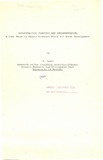Decentralised planning and implementation:a case study of kenyan district focus for rural development
| dc.contributor.author | Agevi, E. | |
| dc.date.accessioned | 2016-12-20T06:50:12Z | |
| dc.date.available | 2016-12-20T06:50:12Z | |
| dc.date.issued | 1989 | |
| dc.identifier.uri | http://hdl.handle.net/11295/98036 | |
| dc.description.abstract | It is common knowledge that many African countries inherited a colonial administrative/development framework which has been countffproductive to the aspirations of the indigenous population. The adminstrative and technical tools of development inherited at independence were largely of a 1 top-down' nature so designed as to accommodate the objectives of the \ colonial leadership. This administrative and development framework has been for a long timeLused wholesale or with /been minor ad j u st.me nt s . It is an established fact that if governments are going to respond more readily to the needs of their rural population they will have to establish a greater presence and solicit the participation of the masses at grassroot level. Kenya has in the p~st tried with varying amount of political commitment to adapt a 'bottom-up' approach instead of 'top-down' approach. | en_US |
| dc.language.iso | en | en_US |
| dc.publisher | University of Nairobi | en_US |
| dc.rights | Attribution-NonCommercial-NoDerivs 3.0 United States | * |
| dc.rights.uri | http://creativecommons.org/licenses/by-nc-nd/3.0/us/ | * |
| dc.title | Decentralised planning and implementation:a case study of kenyan district focus for rural development | en_US |
| dc.type | Other | en_US |
Files in this item
This item appears in the following Collection(s)
-
Research Reports [210]



